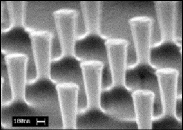Hank Hogan
Photons are gregarious. Unlike electrons, photons have no trouble congregating. For most applications, that's not a problem. However, this behavior makes it difficult to fill regular time slots with a single photon.

Microscopic posts act as single-photon turnstiles, emitting light one photon at a time. Courtesy of Yoshihisa Yamamoto, Stanford University.
Reducing the intensity of radiation ensures that no more than one photon will be in any time slot, noted Yoshihisa Yamamato, a professor of applied phys-ics and electrical engineering at Stanford Uni-versity. But it often means that many available slots have no photons. For some advanced computation and communication techniques, such as quantum computing and cryptography, the dearth of filled slots limits data rates.
Yamamoto and his research team have developed a single-photon turnstile device. Looking somewhat like a miniature array of monoliths, the turnstile produces millions of photons per second, one at a time. It is the converse of one of the most successful photonic devices of all time.
"A laser achieved the ultimate performance of a photon as a coherent wave," Yamamato said. "The single-photon turnstile device achieves the ultimate performance of a photon as a discrete particle."
Appropriately enough for a device useful for quantum computing, the single-photon turnstile makes use of quantum wells. Built in semiconductors, these wells are small enough to trap single electrons that tunnel into them. Once inside the well, the electron keeps another from entering. The same happens for holes, which are charge deficits that act like positively charged particles.
When both a hole and an electron are inside a well, the two recombine, resulting in a single photon. The final element of the turnstile is a 100-nm-diameter post that sits on top of the well. The microscopic post funnels that single photon out to the waiting world. These posts and wells are fabricated in an array, each transmitting a single photon at a time. Because every time slot is filled, bit rates for the single-photon turnstile are substantially higher than the few thousand per second possible with radiation intensity reduction methods.
But there are still some problems to be overcome. First, the device works only at 0.05 °C above absolute zero. Second, the electrons and holes take time to recombine. Third, the efficiency of photon transmission leaves something to be desired.
One solution to some of these problems is to use quantum dots, which, unlike wells, restrict electron and hole motion in three dimensions. Tighter spacing leads to faster electron-hole recombination, increasing data bit rates as much as 200 times.
